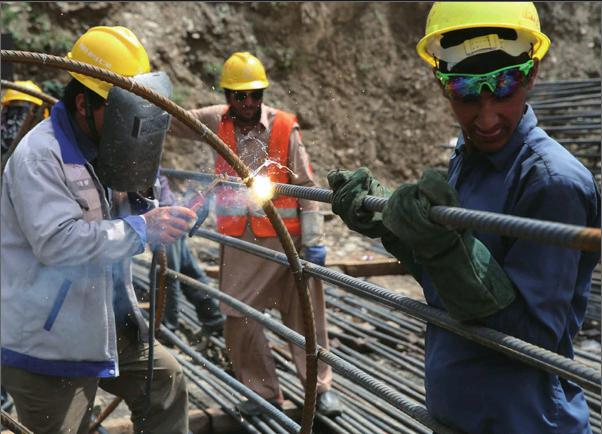A Corridor of Power
2018-01-22ByAhsanIqbal
By+Ahsan+Iqbal

Despite political events in the country created by some narrow vested interests, the Seventh Joint Coordination Committee (JCC) meeting on the ChinaPakistan Economic Corridor (CPEC) was successfully held a month and a half ago in Islamabad.
Our Chinese counterparts showed resolve and commitment to successfully complete all CPEC projects in a timely manner. The Seventh JCC also offi cially approved the Long Term Plan (LTP) of CPEC. It is standard practice around the world for a bilateral agreement not to be made public unless it is approved by both parties, but unfortunately some cynics in the media tried to generate unnecessary controversy by publishing an incorrect version of the LTP. As promised, we have released the offi cial version of the LTP for both the public and the media.
The development of any country is based on its industrialization process. The qualitative difference between the developed and the developing countries is the difference in their degrees of industrialization. With developed countries now entering a postindustrial age, developing countries are still struggling to complete their industrialization process and modernize their economies. The Pakistan Muslim League (PML-N) has believed in, and consistently strived for, the industrialization of Pakistan. In light of this vision, the PML-N government initiated work on CPEC immediately after coming into power in 2013. CPEC has attracted worldwide attention due to its significant contribution toward removing energy and infrastructure growth bottlenecks from Pakistans economy. It provides Pakistan with a great opportunity to leapfrog some, and expedite other, processes of industrialization.
The LTP provides a conceptual framework for CPEC up to 2030, and also delivers a framework for the industrialization of Pakistan. To finalize the LTP, the government of Pakistan consulted the provinces, the federal ministries, and their respective technical groups. The plan is completely in line with the seven pillars of the Pakistan Vision 2025, which are founded on the economic principles of inclusive and sustainable development. The seven salient features of the LTP are connectivity, energy, trade and industrial parks, agricultural development and poverty alleviation, tourism, cooperation in areas concerning peoples livelihoods and non-governmental exchanges and financial cooperation. The spirit of the LTP is best captured in the following statement from the document itself: “...CPEC will greatly speed up the industrialization and urbanization process in Pakistan and help it grow into a highly inclusive, globally competitive and prosperous country capable of providing high-quality life to its citizens.”endprint
Route to success
Below are some of the signifi cant features of CPECs long-term plan to illustrate its central role in the industrialization of Pakistan.
Connectivity is the cornerstone of development. It increases the flow of goods, information and people across regions. That is why an integrated transport system is central to the LTP. It includes the construction and development of Kashgar-Islamabad, Peshawar-Islamabad-Karachi, Hakla-Dera Ismail Khan, Sukkur-Gwadar Port and Dera Ismail Khan-Quetta-Sohrab-Gwadar road infrastructure, which seeks to improve connectivity within Pakistan and interconnectivity with China. The development of Gwadar Port City, Gwadar airport and Easy Bay expressway are going to transform the city of Gwadar into a maritime trade hub and a new smart port city for the region. It will also lead to the industrialization of Balochistan.
Information technology is another crucial aspect for development. In this regard, we have laid a cross-border fi ber optic cable between Pakistan and China, and agreed to cooperate in promoting the technologies of the fourth industrial revolution in Pakistan.
In the energy sector, both countries will enhance cooperation in the fi elds of oil and gas, electricity and power grids. The focus is on thermal power, hydropower, coal gasifi cation, renewable power generation and modernizing power transmission networks. CPEC has already addressed the major energy bottleneck in Pakistan, and over half of the 10,000 MW energy added recently to the national grid comes from CPEC cooperation.
To build an industrial base, new industrial parks and special economic zones will be built all over the country. Both countries will cooperate to improve efficiency in the textile and garment industries, which together make up the backbone of Pakistans export sector. Engineering-based industries will also be developed in Pakistan.
It is important to note that no country has successfully industrialized without also modernizing its agricultural sector. CPEC will allow us to modernize agriculture through the introduction of new technologies such as biological breeding and drip irrigation. The emphasis is to improve the income of small farmers by increasing their productivity and effi ciency.
Coastal tourism can also become a new niche for Pakistan. CPEC will allow us to build coastal leisure and vacationing centers across the Keti-Bander-Karachi, Sonmiani-Ormara, Jhal Jhao, Gwadar and Jiwani routes. CPEC is about cooperation at all levels between both countries, including non-government organizations and people-to-people interactions. For the cross-fertilization of ideas and cultures, the exchange of students, tourists and academics will be an integral component of the corridors plans.endprint
